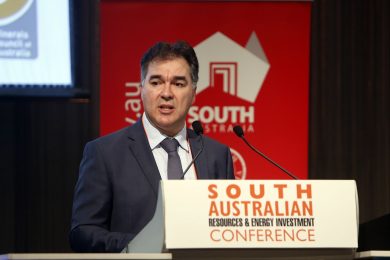The comparable 257 TWh generated by Australian uranium exports last year was equivalent to 103% of the country’s electricity production – establishing a firm platform for a “bigger conversation” around developing an option for nuclear energy in the nation’s future baseload power mix, a key industry lobby says.
The comparison – at a time of raging eastern states debate about sufficient gas supplies for domestic electricity – was given on the second day today of the two day Paydirt 2017 South Australian Resources and Energy Investment Conference in Adelaide by the Minerals Council of Australia’s Executive Director – Uranium, Daniel Zavattiero.
“There remains strong potential for nuclear energy in Australia’s power mix. We have a well-established Australian uranium industry and we have a platform for a bigger conversation around harnessing this baseload energy opportunity,” Zavattiero said.
“Critically, Australian uranium remains an important component of Australia’s energy exports and is of strategic importance to our major trading partners,” he said. “The industry’s safety and environmental performance is strong.
“The National Radiation Regulator reports that the average quarterly effective dose for Australian uranium mining and processing workers has remained relatively constant over the past five years at an exposure level of around 0.4 mSv, far below natural background radiation levels in many parts of the world.
“And a thorough literature review by Ben Heard released by the MCA today on the uranium industry’s environmental record, shows that there is little link between potentially serious environmental impacts and the specific pursuit of mineral uranium. The key determinants of environmental outcomes are the nature of mining practice and regulation, not the mineral in question.”
On Australia’s uranium potential, Zavattiero said the country could readily expand the worth and employment numbers if it positions itself to obtain a higher share of global production, consistent with its higher share of global uranium resources, as the nuclear industry expands over coming decades, particularly in the Asian region.
“In a world where nuclear power grows to 16.6% share of global electricity capacity and Australian uranium grows to 30% of global production, Australian uranium would be fuelling approximately 5% of global electricity capacity with near zero carbon emissions,” he said.
“To realise its potential market share therefore, Australia needs to become known as a high quality reliable producer with a stable, efficient, science-based regulatory environment.”
The MCA supported the South Australian Nuclear Royal Commission’s conclusion that it would be wise to plan now for the possible need for nuclear power in Australia in the future.
Zavattiero agreed with the SA Nuclear Royal Commission that while it was not clear whether nuclear power would be the best choice for Australia beyond 2030, it would be prudent for it not to be precluded as an option.
“Australia should position itself to be able to take advantage of all the potential options. It would be wise to facilitate a technology neutral policy for Australia’s future electricity generation mix,” he said.
“Regarding nuclear power in Australia, the Royal Commission noted that while it did not find it was viable in SA currently, some of the modelling suggested that nuclear might well be viable elsewhere now as the challenges facing baseload generators in SA were not shared with other NEM regions.
“This is the strongest possible argument for the immediate removal of prohibitions on nuclear energy in Australia”.










